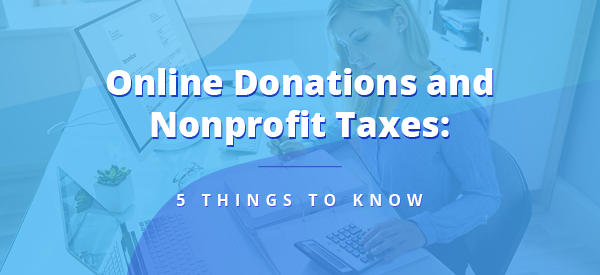
While tax management is an essential financial practice, it can be a pain point for nonprofit professionals. Starting your tax paperwork can be a confusing process if you’ve never done it before, and you likely have a lot of questions about how to get started.
In this guide, we’ll cover five critical things to know about nonprofit taxes:
- Donations to 501(c)(3) organizations are tax-deductible.
- It’s crucial to provide supporters with donation receipts.
- Nonprofits are required to file IRS Form 990 each year.
- There are multiple versions of Form 990 to choose from.
- Your nonprofit tax forms can function as a marketing tool.
As online giving gains traction—63% of donors prefer it, according to Double the Donation—its impact on nonprofit taxes continues to grow. Let’s jump in!
1. Donations to 501(c)(3) organizations are tax-deductible.
Because your nonprofit is eligible for tax-exempt status from the IRS as a 501(c)(3), your supporters’ contributions to your organization are tax-deductible as well.
Although tax breaks are likely not at the forefront of your donors’ motivations for giving, they are certainly a bonus that can encourage more significant gifts and improve your fundraising campaigns. Therefore, be sure to communicate your tax-exempt status with donors and prospects. You can do this by including a note on your online donation page and your website’s “about” page.
2. It’s crucial to provide supporters with donation receipts.
For supporters to receive the tax benefits outlined above, you must provide them with written confirmation of their gift in the form of a tax or donation receipt, regardless of the gift’s size or type.
While the IRS does not require tax receipts to be distributed for gifts smaller than $250, it’s a good practice to provide them to any and everyone who gives—from your small and mid-level donors to your corporate fundraising partners.
To ensure your receipt follows IRS guidelines, include the following pieces of information in every receipt:
- The name of your organization
- The amount of a cash contribution
- A description (but not the value) of a non-cash contribution
- A statement that the organization provided no goods or services in return for the contribution
Automated online donation processes can simplify this process for organizations so they don’t have to manually draft tax receipts with every gift they collect. For example, donors who make Facebook donations automatically receive a tax receipt for their gift, as do those on many other online giving platforms.
3. Nonprofits are required to file IRS Form 990 each year.
While it would be convenient if your nonprofit was only required to file for tax exemption a single year and could forgo tax forms from then on, unfortunately, that’s not how it goes.
To receive tax-exempt status in the first place, your organization must file Form 1023. Then, you’ll need to renew your exemption by completing Form 990 every year.
You’ll need to file your Form 990 by the specified deadline: the 15th day of the fifth month following the end of the organization’s taxable year. If you miss this deadline, your organization can face severe penalties. These include steep monetary fines and, eventually, a loss of tax-exempt status.
For organizations following the calendar year, this date falls on May 15 each year. If you find yourself approaching this deadline and don’t expect to submit your return in time, you can always file Form 8868 instead for a six-month extension.
4. There are multiple versions of Form 990 to choose from.
When you’re ready to start filing your nonprofit tax return, you’ll need to determine which form to complete. Small and mid-sized nonprofits are likely eligible for one of two condensed versions of the Form 990: the 990-N and 990-EZ. However, larger organizations will be required to complete the full return, so make sure you take a look at your annual revenue to determine which category you fall into.
This graphic from File 990 lists the four most common types of nonprofit tax forms and the differences between them:
Alt text: A graphic describing the differences between the types of Form 990 (as described below).
- Form 990 is the IRS form required for the largest group of tax-exempt organizations with annual gross receipts over $200,000. This is the full tax return, and it requires the most detailed information to complete.
- Form 990-EZ is the IRS form that’s one step down from the full return. If your mid-sized nonprofit has annual gross receipts between $50,000 and $200,000, you’re eligible to complete this abridged version instead.
- Form 990-N, also known as the e-postcard, is the IRS’s electronic form for tax-exempt organizations with annual gross receipts totaling less than $50,000. The 990-N is the shortest, simplest form to complete.
- Form 990-PF: Form 990-PF is completed by all private foundations, regardless of their financial status. This typically includes nonexempt charitable trusts as well as tax-exempt private foundations.
Online donations (and the software you use to collect them) can help you determine which form is appropriate for your nonprofit. For example, you likely use an online database to gather information about your donors, track engagement history, and organize key data points. This can come in handy when determining your organization’s annual revenue and filling out your tax forms.
5. Your nonprofit tax forms can function as a marketing tool.
Did you know that your annual Form 990 can also help you build connections with donors and encourage continued support? After you submit your return to the IRS, it becomes a public record, meaning donors, prospects, and other stakeholders can get a glimpse of your nonprofit’s finances. This makes your Form 990 a nonprofit marketing tool of sorts that can fortify your reputation as a trustworthy organization.
Your Form 990 can provide detailed insights into the following elements of your nonprofit:
- Quality of management
- Tax-exemption status
- Mission and vision
- Major programs funded
- Financial management prowess
Essentially, your Form 990 gives donors and prospects a broad overview of your organization and how you allocate your funding. By encouraging transparency and disclosure, nonprofits can earn the trust and confidence of their supporters. When you communicate with your trustworthy financial data, you can encourage new supporters to give.
Nonprofit taxes don’t have to be difficult when you have the knowledge and the tools to support your team. By pairing effective financial practices with successful online fundraising strategies, you’ll effectively make long-lasting change for your mission.
Headshot: Melissa Geitgey.png
Melissa Geitgey
Melissa Geitgey, APR, is the director of marketing for Togetherwork’s higher education product group. Togetherwork is a Saas company that provides integrated software and financial solutions that help organizations and membership groups manage, grow, and engage with their communities.
Melissa has extensive experience leading marketing and communications departments to advance strategic initiatives, managing events and corporate brands for Saas, higher education, athletics, professional services, and nonprofit organizations. She graduated from Valparaiso University with a B.A. in Communications and received her Accreditation in Public Relations (APR) by the Universal Accreditation Board in 2011.
She’s a past president of the Public Relations Society of America Hoosier Chapter and former chapter Ethics Chair. When she’s not geeking out about marketing communications strategy and the creative process, Melissa loves spending time with her family, listening to live music, visiting art museums, restoring vintage handbags and subversive cross stitch.
